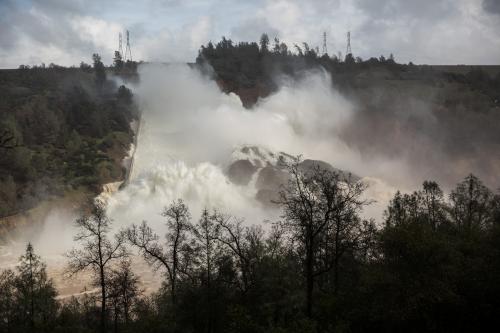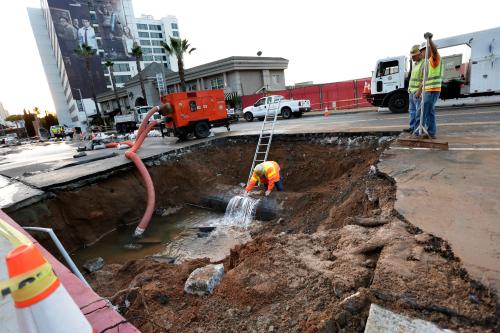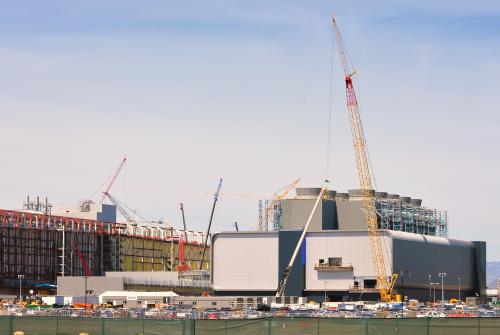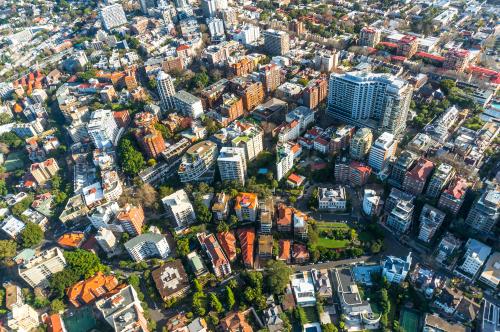Lately, water infrastructure has gained a lot of national attention, although not always for the most reassuring reasons. As President Trump continues to make sweeping calls for infrastructure investment, there are serious questions about funding and project selection, congressional leaders have shown little urgency in nailing down needed details, and federal agencies like EPA are bracing for massive cuts in spending and hiring, with a number of future programmatic and regulatory functions shrouded in mystery.
Despite all of this federal uncertainty, however, cities and states are not slowing down in their water infrastructure plans and investments. As places from New Orleans to Flint to Oroville see the impetus for action, they are exploring new financial tools, designing more resilient systems, and forging stronger collaborations – public, private, philanthropic, and otherwise. These are among a number of efforts already underway in cities and states across the country – but clearly more work remains to be done, especially given the difficulty identifying, measuring, and establishing a clear list of local priorities.
Looking ahead, here are five steps for cities and states to consider as they look to move beyond the status-quo and drive future water innovations, whether Washington takes action or not:
- Emphasize water’s central economic role: Water means business. Millions of households, businesses, and industries depend on reliable water systems to function every day. At the same time, 30 of the country’s largest water utilities support up to $52 billion in economic output and 289,000 jobs annually. Cities must continue to emphasize the economic function of their water systems, including the hundreds of thousands of skilled workers who are vital to long-term operation and maintenance. More investment often means more jobs.
- Invest in new technologies, including those that promote clean energy: Not every infrastructure expenditure is equal, and those who want to rebuild or replicate infrastructure in the same way it was built ten or even thirty years ago should step aside and let American ingenuity shine. Every week, places are learning to do more with less, including the recovery of nutrients previously considered waste. Energy is paramount in this respect. Climate change often reveals itself through changes in water, especially changes in precipitation patterns, which in turn have a tremendous impact on infrastructure and service needs. The more that utilities and other water actors can wean from non-renewable fuels, the more secure the country’s water services and systems can become.
- Invest in flexible infrastructure and prepare for climate fluctuations: While it is hard to predict precise water use patterns, technological developments, and other natural disruptions, communities too often build facilities based on unreliable projections, and ratepayers may have to help utilities deal with extra debt. However, by turning to smaller, modular systems – not necessarily consolidated in one place – communities can gain additional flexibility in the way they handle and treat water. Ideally, these flexible infrastructure systems can handle a variety of climate pressures as well, including more frequent flooding. Water infrastructure is vulnerable, but it does not have to be.
- Bring agriculture into the conversation: The need for water infrastructure innovation straddles urban and rural geographies. Agriculture is one of the largest consumers of water, and in most places is the largest source of water pollution. Advanced technologies that have been developed to treat urban waste can also be applied to on-farm waste, generating clean water and renewable energy. Similarly, agriculture needs sustainable sources of essential fertilizers that can be generated from urban resources recovery facilities.
- Invest in science and be more open to technical collaboration: Of course, to carry out many of these innovations and adapt to other unforeseen challenges, it is crucial to support ongoing investments in science and applied research. As organizations like ReNUWIt and WE&RF demonstrate, investigating new technologies, institutional frameworks, and other decision-making tools can lead to long-term gains in efficiency and sustainability. Supporting technical staff at a federal, state, and local level can also be an easy way to engage more proactively and collaboratively in this shared learning. Sending staff experts to conferences, and sometimes even supporting the conferences themselves, is an efficient way to deliver messages or receive input from large constituencies all at once.
Collectively, these types of priorities can keep momentum going for water infrastructure innovation at a state and local level, even as significant questions on investments, programmatic reforms, and regulatory oversight engulf Washington. Events held during Water Week 2017, for instance, will shine additional light on water’s national importance, including the wide range of players involved all across the country. Any federal efforts – from the Trump administration to Congress to individual agencies – should respond to and reflect many of the innovative regional efforts already underway.








Commentary
Amidst federal uncertainty, five steps to drive future water innovation at the regional level
March 14, 2017